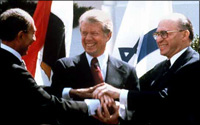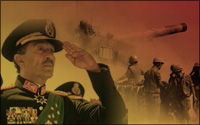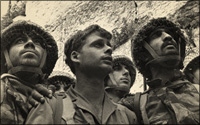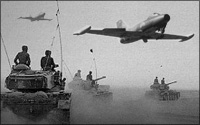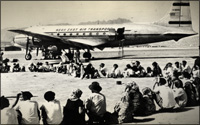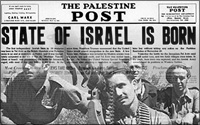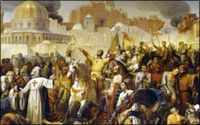 The major watershed of Jewish history in the medieval world is the First Crusade.
The major watershed of Jewish history in the medieval world is the First Crusade.
The Crusades changed all of Jewish life in Europe. It changed the attitude of Christians towards Jews and Jews toward Christians… and even Jews towards Jews.
The Schism
In the year 1054, there was a major split in the Christian world between the Pope of Rome, which is Roman Catholic Christianity, and the Eastern Christian Church, which was then centered in what is called today Istanbul, or then Byzantium, the famous city at the Straits of Bosporus and the Dardanelles.
The Greek Orthodox Church had always been a separate Church from the Roman Catholic Church, but the two had not really split. Now, in 1054, the Greek Orthodox Church severed all relations with the Western Church.
However, the Greek Orthodox Church was soon threatened by the Muslims. The Muslims were in Turkey, and were pressing in what is today Albania and Bulgaria — the whole southern rim of the Balkan states. To relieve the pressure the Greek Orthodox Church was willing to cut a treaty with the Roman Catholic Church. They sent a message to the Pope saying to send an army to Turkey to help them fight the Muslims.
Meanwhile, the old Pope died and the new Pope, Urban II, saw a golden opportunity. He realized that he could now reconcile the Greek Orthodox Church with the Roman Catholic Church. His idea was to raise a Christian army that would be under the command of the Pope. The Pope would send the army first to Turkey to defeat the Muslims and then onward to Jerusalem to capture the holy places from the Muslims and make Palestine a Christian country.
The Nightmare of the Knights
Generally, the population in Europe during the Middle Ages was divided into castes, or as it was called in France, “estates.” The first estate was knighthood, the noblemen. The second estate was the clergy. The third estate was the commoners, and then there were the peasants or serfs who were not even an estate.
The knights were trained for war. Therefore, they could not exist in a time of peace. They were completely non-productive unless they were fighting. Consequently, Europe was in a constant state of war. These wars had nothing to do with the public good, logic or even money. The phenomenon of ever-warring knights had taken on a life of its own. Besides needing war, every knight needed horses, servants, pages, squires… and had to throw a banquet virtually every night. It was its own self-perpetuating industry.
The constant wars sunk Europe into the throes of virtual chaos. Villages were regularly sacked. The men were killed, the women were raped, the children were sold into slavery and all the plunder that could be taken was taken.
That is one of the reasons that a Crusade was such a good idea. The Pope wanted to get the knights out of Europe. It was essential to move them away somewhere. The Crusades was a perfect answer. It solved so many needs at one time.
The Ticket out of Hell
In the Middle Ages, people were always wondering why there was so much trouble in the world. A preacher named Peter the Hermit said that all the troubles were rooted in the fact that the Holy Land was in the hands of non-believers, the Muslims. If somehow that situation could be rectified the world would settle into peace and tranquility. Therefore, he preached the Crusades and the Pope gave it his blessing.
Although he got everyone’s attention, it was not enough. The Pope had to sweeten the ante. And he did.
In Christian belief, and in the Roman Catholic Church especially, every person is born damned. Therefore, every person has to do something positive to get out of Hell. Otherwise, the mere fact that one is born is enough to force someone into Hell. That is the doctrine Original Sin.
(In Judaism it is just the opposite. Judaism teaches that all Jews start out as going to Heaven. One has to lose it.)
The Church was the repository of the method of being saved. If the Church granted a person either absolution, which is forgiveness from sin, or indulgence, which means overlooking the sin, then in Heaven they had to agree with the Church.
So the Pope said, “Anyone who goes on the Crusades is granted forgiveness for his sins.”
Of course, the elements this attracted were the criminals, sadists, etc. – all the people who had no other way to get into Heaven. Therefore, to go on its holiest mission the Church sent its unholiest clientele.
Destroying Non-Believers… of All Persuasions
In the year 1095, the Crusade was preached by Pope Urban II and Peter the Hermit. The estimates are that over 60,000 men took up the call. However, only 15,000 survived the trek and reached Jerusalem. It was a long, dangerous journey in a time of plague, hunger and war. Most simply did not make it.
Nevertheless, they did wreak much havoc along the way and the main reason is because the Crusades marked the first time in the history of Europe that an army was assembled for a purely religious reason. That is vital to understand. That is the turning point here. The word “crusade” means to take the cross; all the soldiers put on a tunic or mantle that had a cross on it.
Therefore, even as the invaders headed out they thought to themselves that if they were going on a religious crusade against the non-believers, why wait until Turkey or Palestine? There were non-believers in their midst: the Jews, who killed Jesus, and who refused to adopt Christianity and whose beliefs.
There is a book entitled, Europe and the Jews. It was written by a Roman Catholic Priest, Xavier Malcolm Haye. It is subtitled, The Pressure of Christendom on the Jewish People for 1900 Years and documents Christian anti-Semitism over the years. It is powerful beyond words. Here is an example from it about a sermon preached on the eve of the Crusades by one of the leading cardinals of France:
The Jews are slayers of the Lord, murderers of the prophets, adversaries of God, haters of God, men who show contempt for the law, foes of greats, enemies of their father’s faith, advocates of the devil, brood of vipers, slanderers, scoffers, men whose minds are in darkness, leaven of the Pharisees, assemblies of demons, sinners, wicked men, stoners, haters of righteousness.
In this climate of hatred stirred by the people who could offer salvation, it is not hard to imagine the mood of the mob. It caused a series of pogroms unmatched in the previous history of Europe. All told, there were perhaps 25,000 Jews killed.
In our time, it may not seem like a lot. Auschwitz, at its height, could do that in two or three days. But you need to remember that everyone had to be killed by hand in the Middle Ages. After a while one’s arm gets tired. There is a physical limit to how many people one can kill, unlike the modern world. We have unlimited possibilities because of technology.
The First Crusade was almost exclusively French. In fact, they were called the Frankish knights. They despoiled the great Jewish communities of Speyers, Worms and Mainz. Besides the thousands of Jews killed, others thousands were forcibly converted.
It was the first time in Europe that there was a mass forcible conversion of Jews. This would also set the stage for the Spanish Inquisition. The choice was given to a Jew to convert or be martyred.
The Church itself viewed the matter ambivalently. It really depended on the local bishop or cardinal. Some of them, such as in the city of Cologne, tried to protect the Jews. Some bishops were killed because they protected the Jews. However, some clergy looked the other way or even extorted money from the Jews on the premise of promising protection — and upon receiving the money gave them up to the mob.
The Crusades Come to Town
It took two years for the Crusaders to reach the Holy Land.
In 1098, we find them in Turkey. They made an alliance with the Greek Orthodox and fought the Muslims in a number of places — and were successful. They defeated the Turks and Muslims, and created a kingdom called Edessa. This kingdom was mainly Armenian Christians who lived in Turkey. Godfrey of Boullion’s brother became the king of Edessa.
Then the Crusaders turned to south, to Antioch, the famous port in Syria (still today). They conquered it and created the Kingdom of Antioch.
Further south they conquered Tripoli (today northern Lebanon; not the Tripoli in today’s Libya), and made the Kingdom of Tripoli.
Then they came all the way south into Palestine, and conquered Jerusalem on July 4, 1099. In celebration of the event, they took all of the Jews in Jerusalem (estimates vary from 900-3,000), gathered them in all the main synagogues and burned them down, thereby destroying the Jewish population in Jerusalem.
The Aftermath
When Godfrey of Boullion declared himself King of Jerusalem the First Crusade officially ended. It was a tremendous success from the Christian point of view. The Dome of the Rock, the mosque on the Temple Mount, which had been built in the ninth century, was converted into a Church. Christians came from all over Europe to celebrate their victory and the rededication of Jerusalem.
After the First Crusade there were not more than 3-4,000 European Christians who actually lived in Palestine. However, they converted many Arabs to Christianity, giving them the choice of conversion or death. That was the beginning of the Christian Arab population, which exists still today in Palestine, Lebanon and the Middle East. That also explains blue-eyed, blond hair Arabs.
One of the strangest things in history is that as the Christians came to settle in Palestine, Jews came to reestablish the presence of Jews there with them! This was because the Christian crusaders were completely dependent upon supplies and merchandise reaching them from Europe — and the Jews were in that business.
It was a terrible paradox: the Christian kingdom was in effect supported and aided by the Jews, who were its lifeline!
After their victory, the Christians set about fortifying their gains and building the land. They took over the seacoast of Israel and the Galilee. Then they tried to extend their gains by capturing Damascus and other cities that were far from the seacoast, but they failed. They were far from their line of support, and this courted disaster.
In addition, they were not very diplomatic with the Arabs. The Christians misgauged very badly what their effect on the Arabs would be.
The Arab Empire Strikes Back
As a result, the Arabs united under Nur ad-Din. He was the first one to raise the banner of Jihad, a “holy war.”
The Jihad against the Christians sought to drive them from Jerusalem, Palestine and the entire Middle East. The Christians responded by proclaiming the Second Crusade. Just as in the First Crusade, they stopped and destroyed many Jewish communities on the way to save the Christian empire from Jihad. This time they also destroyed Greek Orthodox communities because they were non-believers.
The invaders were so tired by the time they came to the Middle East that they could not be successful against the Muslims.
After Nur ad-Din died, Saladin, the famous Muslim warrior (which means “successful judgment”) became the sultan in Cairo, Egypt. He was the sultan that Maimonides served under as his doctor and that is why he had a very benevolent attitude toward Jews.
Saladin was a great warrior, but even a greater diplomat. He pulled together the Arabs and made all the fragile alliances work. He isolated the Crusaders and exploited their own quarrels.
Finally, in 1187, near Tiberius in present day Israel, at a place called Karnei Hittim (meaning “Horns of Hittim” because the double hill looks like horns) an epic battle took place. It had been a famous battlefield in the days of Joshua, King David, the Maccabees, Herod and the Romans. Now, it was the battlefield of the Crusades.
For some unexplainable reason, the Crusader army left the safety of the castle of Tiberius on a hot day. Carrying 60 pounds of armor, they walked 18 miles to the battlefield and arrived at the valley while Saladin’s army stood well-rested and strategically located at the top of the hill. They were completely wiped out. Saladin captured Jerusalem, took the Temple Mount and made it a mosque again.
Of the three French generals, one was killed, one was ransomed, and the third was forced to convert to Islam. That was the beginning of the end of the Crusaders. They never recovered from it.

